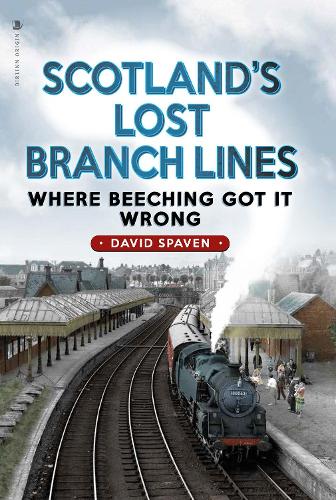Leugh mi leabhar fìor mhath mu rathaidean-iarainn na h-Alba bho chionn ghoirid agus sgrìobh mi an lèirmheas seo air Goodreads. Shaoil mi gum biodh e math a chur suas air a’ bhloga, ged a tha e sa Bheurla.

In Scotland’s Lost Branch Lines – Where Beeching Got it Wrong, transport expert and activist David Spaven looks at how and why all of Scotland’s rural branch lines came to be closed.
While there is a tendency to look at all railway closures as the fault of Dr Beeching, Spaven reminds us that this is not the case. He goes on to put Beeching report into its broader historic context, looking at branch line closures under the Big Four and by BR before Beeching and at the subsequent closures in the late sixties and early seventies, many of which inot recommended by his Reshaping British Railways report.
Beeching has always been something of a folk enemy and his name is infamous even today some 60 years on. In recent years, some people have taken a revisionist view of the railway axe-man. Spaven notes that the remit handed to Beeching was somewhat narrow and was aimed purely at bringing the railways into profit and did not consider the broader socio-economic importance of the railways. However, as the book points out using a great deal of historic research and railway expertise, Beeching’s analysis could be said to be very weak even within the remit handed to him by the even more villainess Ernest Marples, Minister for Transport.
It has often been pointed out before that the report was based on figures taken at periods of the year that didn’t take account of seasonal traffic. The robustness of the figures has often been challenged too as has Beeching’s overoptimism that passengers would continue to use rail services from the nearest railhead following closure of their local branch line.
Spaven’s main thesis is that in addition to these weaknesses, Beeching also failed to consider measures short of closure which could have allowed the maintenance of branch lines. Looking at a range of case studies including Ballater, Peterhead/Fraserburgh, Ballachulish, Crieff, Callander, Peebles and the Fife Coast line amongst others, the author argues that the potential of costs savings through de-staffing stations, singling tracks, closing little-used stations and reducing the numbers of manual level crossings and signal boxes could have radically reduced the cost of running many of the lines. Increased service levels using modern DMUs would also have helped, increasing the attractiveness of rail travel, particularly if combined with improved promotion and fare reform.
It is recognised that some railways were so uneconomic as to have been candidates for closure in any situation, however, many others are shown to have had a lot more life in them at the time of closure.
The book finishes with chapters on lessons learnt and the future of branch lines. The latter looks at the most likely future reopenings and the potential of tram-trains and the integration of railways with official ScotRail coach services.
While Spaven isn’t expecting a revolution in building new branch lines in Scotland any time soon, he is relatively optimistic about the future and puts forwards many good suggestions. One of the compelling ideas of the book is that there was a fatalism about the railways in the 1960s, shared by the public, railway workers, politicians and trade unions alike that railways were largely a thing of the past and their decline inevitable. This led to pessimism about saving lines and failure to consider alternatives to closure.
With congested cities and the environmental crisis, the pendulum is turning in the other direction with a widely shared view that railways and public transport in general are the way forward. Opening or reopening railways is a slow, difficult and expensive business but this spirit of the age
makes for a hopeful future. We’re soon to see the Leven Line reopen. Where will be next? St Andrews? Ellon/Peterheid/Fraserburgh?
Finally, Spaven also proves that it is still OK to see Beeching as a baddie!
This book is not only a fascinating read, but contains many photographs, many from Spaven’s own collection and has a table with the dates of closures of the different branch lines which readers are likely to find themselves referring back to often.
Alasdair
Tadhail air Trèanaichean, tramaichean is tràilidhean
Powered by WPeMatico

